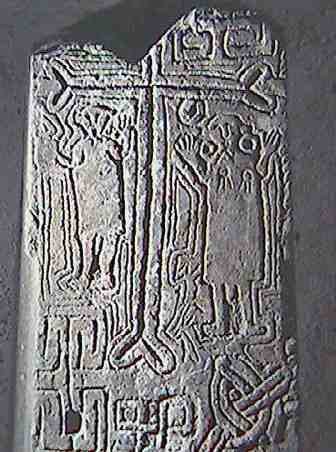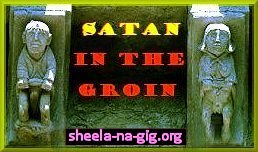Burford (Oxfordshire)
This carved stone slab now set high in the stair turret in the South aisle
of the church of St John the Baptist
is 11th or 12th century. The figure on the right is a centaur: as theriomorphic
and unnatural (therefore evil) accomplice
- which is being attacked (?) by an animal (or a peacock ?).
On the left, a female with vulva as large inverted V is groped by a male with
broken penis poking from beneath his skirt.
The skirt suggests that he might be a priest or monk, in which case the panel
is an attack on Concupiscence amongst the clergy,
a serious problem right up until the Reformation.

photograph by Tina Negus
Click for more centaurs and a couple >
Compare this panel with one at Poitiers in France >
|
and compare also with the remarkable cross-slab at Llanhamlach in Brecon (Powys). The church of St.Peter contains the Ioannis Moridic stone pictured on the left. It is thought to be no later than the 11th century and there is also some conjecture that the stone that it could be two or three centuries earlier. There is a latin inscription on the right hand edge which reads IOHANNIS / MORIDIC SUREXIT HUNC LAPIDEM which is thought to mean "Moridic erected this stone". There is a marked space and slash between the IOHANNIS and MORIDIC. According to a sign on the church SUREXIT is thought to be an error on the part of the sculptor who had an incomplete grasp of Latin. The IOHANNIS is thought to be part of another inscription which is now lost. What is most intriguing about the stone is the two figures carved either side of the decapitated cross. Both appear to have "penises" peeking from beneath their garments yet the right hand figure also appears to have breasts with "rays" emanating from them possibly indicating milk. Both figures hold their hands in the air and the right hand figure also appears to have "earrings" i.e. circles either side of the head. The stone appears in the 1876 book "Lapidarium Waliæ" by J.O. Westwood, who identified the figures as Adam and Eve under the tree of knowledge and the Virgin Mary and St John standing beside the cross in turn ! Typically, he made no mention of the members between their legs, and the illustration in the book omits them altogether. This is yet another example of the widespread Victorian bowdlerisation of carvings.
|
Compare the figures on this stone with the "Three Disgraces" at Burford (above), where the middle figure is carved in a similar manner with a penis peeking from beneath a shift. It's very hard to say what this stone is meant to represent with its confusion of sexual symbolism. (Text by John
Harding, |
The Llanhamlach scene may well represent two monks.
It could represent Sacred Marriage.
See Boswell, John: THE MARRIAGE OF LIKENESS
- SAME-SEX UNIONS IN PRE-MODERN EUROPE (HarperCollins 1996)
- a vital text for the understanding of early Christianity and
monasticism.

